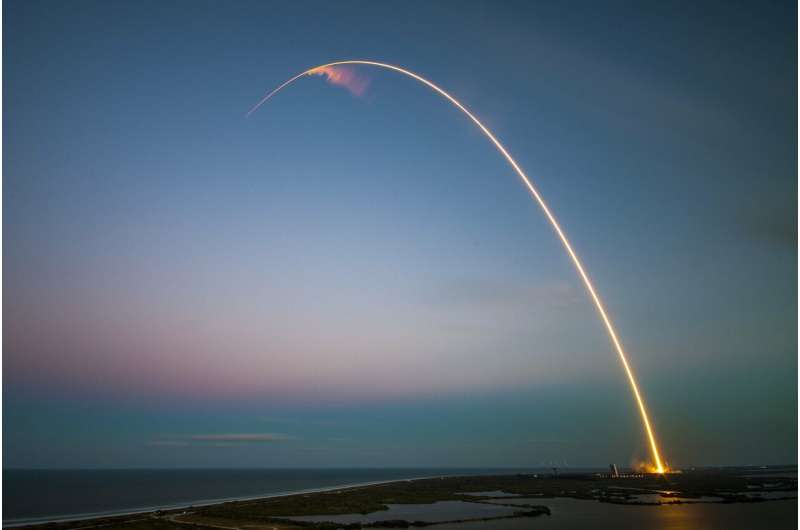
Copernical Team
Change in the Arctic
 Video:
00:03:17
Video:
00:03:17
Satellites play a vital role in monitoring the rapid changes taking place in the Arctic. Tracking ice lost from the world’s glaciers, ice sheets and frozen land shows that Earth is losing ice at an accelerating rate. Currently more than a trillion tonnes of ice is lost each year. The sooner Earth’s temperature is stabilised, the more manageable the impacts of ice loss will be.
SpaceX launch delayed due to astronaut 'minor medical issue'

Final decision on Georgia spaceport permit delayed yet again

A federal agency has yet again pushed back a final decision on whether to allow the construction of a launchpad for commercial rockets in coastal Georgia.
The Federal Aviation Administration plans to release its decision on Spaceport Camden by Dec. 15 rather than this Wednesday, agency spokesman Steve Kulm said. An agency statement cited a delay caused by "ongoing consultation efforts." The final determination was originally expected at the end of July but now has been delayed at least three times.
Camden County, in the southeast corner of Georgia, wants to build the nation's 13th licensed commercial spaceport and has spent nearly 10 years and $10 million pursuing that goal. The FAA in June issued an environmental impact study that concluded building the spaceport would be its "preferred alternative."
That drew pushback from the National Park Service and its parent agency, the U.S. Department of the Interior. In a July 22 letter to the FAA, the Interior Department said a chance of rockets exploding and raining fiery debris onto the federally protected wilderness on Cumberland Island creates an "unacceptable risk.
Physicists discover how particles self-assemble
 A team of physicists has discovered how DNA molecules self-organize into adhesive patches between particles in response to assembly instructions. Its findings offer a "proof of concept" for an innovative way to produce materials with a well-defined connectivity between the particles.
The work is reported in Proceedings of the National Academy of Sciences.
"We show that one can progra
A team of physicists has discovered how DNA molecules self-organize into adhesive patches between particles in response to assembly instructions. Its findings offer a "proof of concept" for an innovative way to produce materials with a well-defined connectivity between the particles.
The work is reported in Proceedings of the National Academy of Sciences.
"We show that one can progra Better climate data through ten times more accurate satellite navigation
 Satellites provide important data on climate and the environment every day. According to initial tests, new software from RUAG Space can determine the real-time position of a satellite in space ten times more accurately than was previously possible. More accurate positioning data leads to more precise satellite data and helps to avoid space debris.
Every day, satellites provide important d
Satellites provide important data on climate and the environment every day. According to initial tests, new software from RUAG Space can determine the real-time position of a satellite in space ten times more accurately than was previously possible. More accurate positioning data leads to more precise satellite data and helps to avoid space debris.
Every day, satellites provide important d The silent build-up to a super-eruption
 It is estimated that about 5-10 volcanoes worldwide are capable of producing a super-eruption that could catastrophically affect global climate. One of these volcanoes hides below the waters of Lake Toba in Sumatra and has caused two super-eruptions in the last one million year. But when will the next one be? Will there be any warning signs?
To answer these questions, an international team
It is estimated that about 5-10 volcanoes worldwide are capable of producing a super-eruption that could catastrophically affect global climate. One of these volcanoes hides below the waters of Lake Toba in Sumatra and has caused two super-eruptions in the last one million year. But when will the next one be? Will there be any warning signs?
To answer these questions, an international team Uncovering the secrets behind Earth's first major mass extinction
 We all know that the dinosaurs died in a mass extinction. But did you know that there were other mass extinctions? There are five most significant mass extinctions, known as the "big five," where at least three-quarters of all species in existence across the entire Earth faced extinction during a particular geological period of time. With current trends of global warming and climate change, many
We all know that the dinosaurs died in a mass extinction. But did you know that there were other mass extinctions? There are five most significant mass extinctions, known as the "big five," where at least three-quarters of all species in existence across the entire Earth faced extinction during a particular geological period of time. With current trends of global warming and climate change, many Groundbreaking findings in hunt for new neutrinos in the universe
 Illinois Institute of Technology Associate Professor of Physics Bryce Littlejohn is part of an international team of scientists that has dealt a blow to a popular theory of the existence of a fourth "sterile" neutrino. The groundbreaking research results were announced at Fermi National Accelerator Laboratory today.
Neutrinos, which come in three known "flavors," are smaller than atoms and
Illinois Institute of Technology Associate Professor of Physics Bryce Littlejohn is part of an international team of scientists that has dealt a blow to a popular theory of the existence of a fourth "sterile" neutrino. The groundbreaking research results were announced at Fermi National Accelerator Laboratory today.
Neutrinos, which come in three known "flavors," are smaller than atoms and BICEP3 tightens the bounds on cosmic inflation
 Physicists looking for signs of primordial gravitational waves by sifting through the earliest light in the cosmos - the cosmic microwave background (CMB) - have reported their findings: still nothing.
But far from being a dud, the latest results from the BICEP3 experiment at the South Pole have tightened the bounds on models of cosmic inflation, a process that in theory explains several p
Physicists looking for signs of primordial gravitational waves by sifting through the earliest light in the cosmos - the cosmic microwave background (CMB) - have reported their findings: still nothing.
But far from being a dud, the latest results from the BICEP3 experiment at the South Pole have tightened the bounds on models of cosmic inflation, a process that in theory explains several p New roles, combined offices for NASA Administrator Leadership Team
 NASA Administrator Bill Nelson is announcing new leadership roles, as well as the merging of two offices into the Office of Technology, Policy, and Strategy (OTPS), in support of Biden-Harris Administration priorities and the focus on space strategy.
OTPS is being established to provide data- and evidence-driven technology, policy, and strategy advice to NASA leadership. The office is a me
NASA Administrator Bill Nelson is announcing new leadership roles, as well as the merging of two offices into the Office of Technology, Policy, and Strategy (OTPS), in support of Biden-Harris Administration priorities and the focus on space strategy.
OTPS is being established to provide data- and evidence-driven technology, policy, and strategy advice to NASA leadership. The office is a me 
































